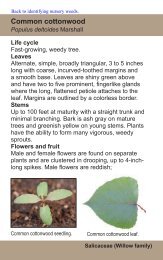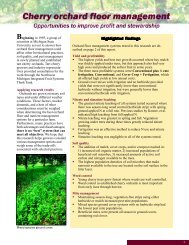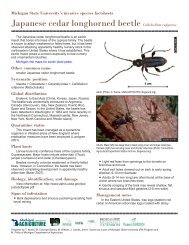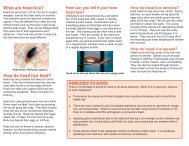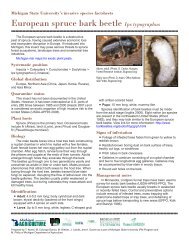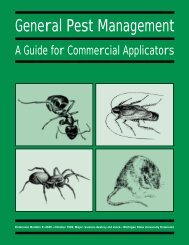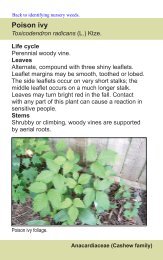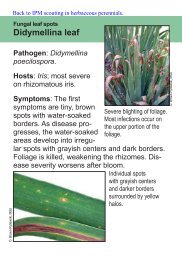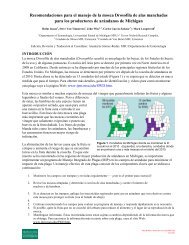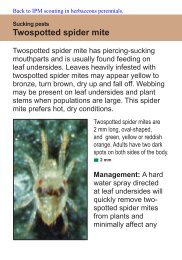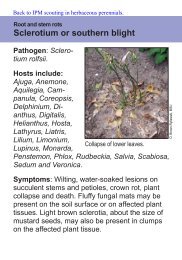Whole Manual - Michigan State University: Integrated Pest ...
Whole Manual - Michigan State University: Integrated Pest ...
Whole Manual - Michigan State University: Integrated Pest ...
You also want an ePaper? Increase the reach of your titles
YUMPU automatically turns print PDFs into web optimized ePapers that Google loves.
FUSARIUM YELLOWS<br />
Environmental conditions favoring disease: The fungus<br />
overwinters in crop debris and is easily spread. The fungus<br />
is most active in cool temperatures.<br />
Fusarium yellows causes the water-conducting tissue of a<br />
celery plant to turn brown.<br />
Pathogen type: fungus (Fusarium oxysporum f. sp. apii)<br />
Disease symptoms: Plants may become stunted and<br />
yellow and exhibit poor growth. The water-conducting<br />
tissues of the crown, petiole, and roots turn brown.<br />
Leaves become brittle and rough and curl upward.<br />
Environmental conditions favoring disease: Symptoms<br />
are most severe when soil temperatures are warm.<br />
Fusarium yellows can be spread readily by movement of<br />
infested soil or transplants. The fungus infects common<br />
weeds such as lamb’s quarters, smartweed, barnyard<br />
grass, and purslane, and can survive for long periods in<br />
soil as dormant spores. This allows the fungal population<br />
to grow in the absence of a celery crop.<br />
Black leg on cabbage.<br />
BLACK ROT<br />
Control strategies:<br />
■ Plant resistant or tolerant celery cultivars.<br />
■ Avoid planting celery into fields with known histories<br />
of Fusarium yellows.<br />
■ To avoid infestation of clean fields, keep equipment<br />
free of infested soil.<br />
■ Control weeds that serve as alternate hosts.<br />
DISEASES OF COLE CROPS<br />
(cabbage, broccoli, cauliflower)<br />
BLACK LEG<br />
Pathogen type: fungus (Phoma lingam)<br />
Disease symptoms: Dark, sunken cankers at the stem<br />
base or light brown, circular spots on the leaves are the<br />
early symptoms of black leg. Eventually, the cankers girdle<br />
the stem and move down to infect the roots. Small<br />
black specks—spores—can also be seen inside the<br />
cankers and spots.<br />
Cabbage infected with black rot (top); inside of a cauliflower<br />
stem infected with black rot (bottom).<br />
Chapter 7<br />
64<br />
Vegetable Crop <strong>Pest</strong> Management



